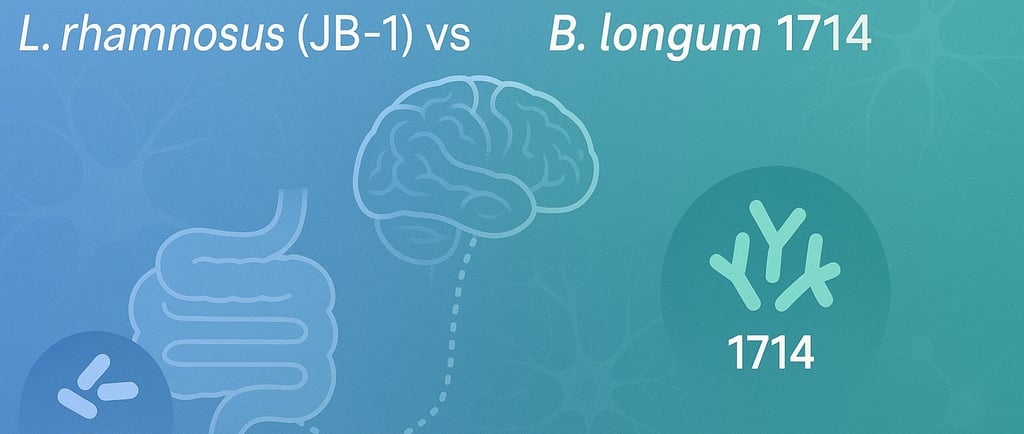Probiotic Face-Off: Lactobacillus rhamnosus (JB-1) vs Bifidobacterium longum 1714 for Anxiety, Stress & Sleep
Guide to strain-specific psychobiotics for calmer days and better sleep
8/21/20253 min read


TL;DR (for busy readers)
Best bet right now: B. longum 1714 — multiple human studies suggest it can buffer stress responses and modestly improve subjective sleep quality in otherwise healthy adults.
JB-1: fascinating animal data, but a human trial in healthy men found no meaningful benefit vs placebo on stress markers, mood, or cognition.
If you’re choosing today in the U.S.: go with B. longum 1714 for 4–8 weeks before judging results.
Why strain names matter (not just species)
“Lactobacillus” or “Bifidobacterium longum” on a label doesn’t tell you enough. Effects are strain-specific. JB-1 and 1714 are different “genetic individuals” with different evidence. If the label doesn’t list the exact strain (e.g., “B. longum 1714™”), assume it’s not the same thing from the studies.
Head-to-head: Evidence at a glance
FeatureL. rhamnosus (JB-1)B. longum 1714Core claimAlters GABA signaling via the vagus nerve (animal studies)Buffers stress reactivity; small, subjective sleep gains; brain-activity changes under stressHuman dataNull in a healthy male RCT (no benefit vs placebo)Multiple human trials: lower perceived stress/cortisol output in lab stressors; early, subjective sleep improvements (no objective actigraphy change)Typical study doseNot established for consumer use1 billion CFU/day for 4–8 weeksU.S. availabilityAuthentic JB-1 consumer products are rareWidely available as 1714™ in practitioner and retail lines
What each strain actually did
L. rhamnosus (JB-1)
Animal research: Reduced anxiety-like behavior and shifted GABA receptors in brain regions through the vagus nerve (cutting the vagus removed the effect).
Human research: In a controlled trial with healthy men, JB-1 didn’t beat placebo on stress hormones, inflammation, EEG, or cognitive tasks. Translation to real-world benefit is unclear.
B. longum 1714
Stress buffering: In healthy adults, 1714 has been linked with lower cortisol output and reduced perceived stress during standardized lab stress tests.
Brain activity: Neuroimaging work shows changes in neural oscillations (resting and under social stress) consistent with better coping.
Sleep: In adults with poor sleep quality, subjective sleep components (e.g., sleep quality, daytime function) improved earlier with 1714; objective wearables didn’t change. Expect modest, early “feel” improvements, not dramatic tracker shifts.
How to use B. longum 1714 (simple, U.S.-ready)
Dose & timing
1 billion CFU once daily, preferably with breakfast.
Trial length: 4–8 weeks. Many people notice any benefit by week 4.
Good stacks
AM: L-theanine 100–200 mg (with or without coffee) for calm focus.
PM: Magnesium glycinate (200–300 mg elemental) or magnesium L-threonate 60–90 minutes before bed for wind-down.
What not to expect
Rapid, sedative-like effects.
Big changes on Oura/Whoop/Apple Watch metrics.
Should you try JB-1?
Availability: Authentic JB-1 is hard to find in U.S. consumer products. Most labels that say “L. rhamnosus” are not JB-1.
Evidence in healthy adults: No clear benefit vs placebo so far. Interesting biology, but not the pragmatic pick for U.S. readers today.
Safety notes (read this)
Both 1714 and JB-1 have been well tolerated in studies.
Possible transient bloating/gas in week one.
If you’re immunocompromised, have a central line, or a history of SIBO/bacteremia, talk to your clinician first.
Separate from antibiotics by a few hours.
Where to buy in the U.S. (what to look for)
Look for “Bifidobacterium longum 1714” or “1714™” on the facts panel.
U.S. products often marketed as Zenbiome™ COPE or Zenbiome™ SLEEP (practitioner lines), and select retail equivalents.
Be careful not to confuse with B. longum 35624 (Align®) or other B. longum strains—different strain, different evidence.
(No affiliate links included—add your own where appropriate.)
A simple 8-week protocol to try
Weeks 1–8: B. longum 1714 — 1B CFU every morning with breakfast.
Optional supports:
AM: 100–200 mg L-theanine.
PM: Magnesium glycinate or L-threonate before bed.
Track Perceived Stress Scale (PSS) weekly and PSQI at baseline, week 4, and week 8. Expect any change primarily by week 4.
Bottom line
If you’re shopping in the U.S. and want a single psychobiotic with the best human signal for stress resilience (and a small nudge to subjective sleep quality), choose B. longum 1714. JB-1 remains scientifically intriguing but not yet a practical U.S. pick.
Trust the science
Natural supplements backed by clinical research.
support@mindrestore.org
© 2025. All rights reserved.